Interview With Director Eric D. Anderson Over At the Indieflix Blog
“Cinema is an emotional medium first of all, and an intellectual one later. Movies have this effortless ability to forge an instant connection with the viewer and transport them to another place and another time, and this is what I find so compelling. We want to be transported. We want to be affected, to feel. It may seem strange for a documentary filmmaker to be speaking in these terms, but I think it’s important to remember that the viewers are going to respond first to an emotional connection with the material, even if it’s a documentary. Especially if it’s a documentary. You must forge this emotional bond with the viewer…otherwise you’re a failure. Then you’re about as interesting as an insurance seminar.”
Filmmaker Spotlight: Eric D. Anderson | The Indieflix Blog
There’s also a link at the bottom of the interview that connects to the entire uncut interview with Anderson. Check it out!!!
Way of the Puck Available Now at Indieflix!
WOTP Acquired by Indiepix
Slate Magazine’s Stefan Fatsis Gives WOTP an Enthusiastic (and Persuasive) On-Air Endorsement
“Way of the Puck lovingly captures the rituals, lore and joy of this nebbishy, throwback American subculture. And it does so because director Eric Anderson resists the temptation to condescend to air hockey’s band of quirky devotees. As a subculture geek myself, respect matters. Praise the table!”
~ Stefan Fatsis, author of Word Freak: Heartbreak, Triumph, Genius, and Obsession in the World of Competitive Scrabble Players; NPR commentator; panelist on Slate.com’s sports podcast “Hang Up and Listen.” Listen to review at 40-minute mark HERE!
WOTP Now Available As a Digital Download on Amazon
Way of the Puck is now available as a digital download at Amazon for only $7.99. If you’re just interested in watching the film and not so interested in any of the bonus features or packaging, this could be for you! See the link for further details…
http://www.amazon.com/Way-Puck-Mark-Guru-Robbins/dp/B007QP3EZK
Quality Review at Curled Up With A Good DVD!
By Eric Renshaw
If you’re anything like me, you play air hockey poorly, fumbling the puck and shooting it into my own goal. The players featured in Way of the Puck have the skills to put me to shame (better than even I can myself), and they all share a rabid love of the game.
Many of them have been playing since air hockey hit the scene back in the ’70s. They shun holding the rounded handle that juts from the top of a traditional air hockey mallet, opting instead for a three-fingered grip on the mallet that gives them more control.
Director Eric D. Anderson, himself a competitor, traces the history of the game and details the lives of several players who compete in national championships. Mark Robbins (“The Guru”) is an encyclopedia of knowledge, and his garage holds a fortune in equipment and treasures (including a virgin table, mint in box). Tim Weissman (“The Ex-Champ”) is credited with creating the circle drift and with bringing thought and strategy to the game. Andy Yevish (“The Promoter”) is an artist whose wife is not exactly thrilled with all the time Andy spends promoting, arranging and playing the sport.
Way of the Puck calls to mind King of Kong: A Fistful of Quarters in how the players’ dedication is portrayed and how the tournaments are covered. Both films brought a true excitement to subjects that don’t set my soul on fire by their nature. It also reminds me of the clever documentary Welcome to Macintosh, mostly in the time spent on Mark Robbins – the trip through the stuff in his barn shares similarities with scenes in Welcome to Macintosh.
To take a subject like air hockey that has a, shall we say, less than massive following, to make it interesting and compelling enough to inspire its viewer to want to seek out that mostly ignored air hockey table at the local arcade and try out that three-finger grip is quite an accomplishment. I say well done.
Lost Interview With Venezuelan Sensation Pedro Otero
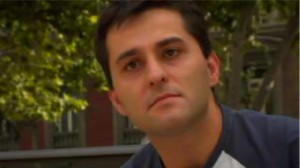
Pedro Otero
If Jose Mora is lithe, lanky, elegant Seattle Mariner Ichiro Suzuki, then Pedro Otero is power hitter Hideki Matsui. All honed their skills playing professionally abroad, then emerged as dominant “rookies” on the international scene. Unbelievably, Otero competed in only four world championships, finishing second in 1998, 1999, and 2000, and finishing fifth in 2001. It is a masterfully short career, and Pedro has probably the highest average finish-per-event in air hockey history. Known for his rock-solid defense, and uniquely powerful (and difficult to defend) right-wall-over, Pedro lived in the competitive shadow of his friend and fellow countryman Jose Mora, who edged him out in three successive tournaments.
We traveled to Madrid to speak with Pedro back in the summer of 2004. The footage was never used in the film, but we wanted to publish a short excerpt of the interview and wish him well.
WOTP: Can you tell me how you got started?
PEDRO: I began playing in the city of Caracas in Venezuela in 1994. I was seventeen years old, and I began playing with some friends. We played our games at Arcade City, which is where we played for many years. Over time, more people joined us. My normal practice partner was Jose Mora. We spent a lot of time practicing together. I can say that our levels were equal because of our consistent practice. We practiced very often, practically every day, and that helped us reach a level that allowed us to travel in 1998.
WOTP: How did that all come about?
PEDRO: In 1998 Jose and I decided to travel to the international tournament in Santa Cruz, California. Tim Weissman helped us in our adventure –- to find some manner to travel to the United States. He made a collection of money amongst the players over there. And he facilitated ticketing information and things like that. I can say that if it were not for him, I believe that we would never have been able to go.
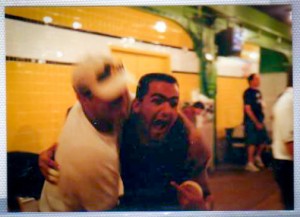
The exuberant Jose Mora
But we still had to embark on a 79-hour one-way bus trip once we arrived in the United States, without knowing, really, what expectations we had for winning, nor having been able to compare or contrast or playing level with the players there. I realize it was a stupid thing to do, an odyssey based more than anything on youth. But in reality, I’m sure neither Jose nor I regret it. And the fruits of this [Jose and Pedro finished first and second place] demonstrate that it was worth the effort.
WOTP: Were there style differences that allowed you succeed against the US players?
PEDRO: I believe that our style is different because in Venezuela we had many more players to compete against – the player base in Caracas was larger than any other city in America, except maybe Houston. There was more of a variety of rivals, which is why I think our style had to be much more complete. We could not just mold ourselves to the characteristics of one player. We had to have a game that was more compact and as complete as possible.
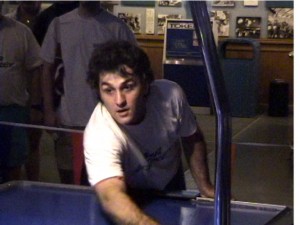
Pedro hits his unique RWO (Right Wall Over)
When I beat Tim Weissman in the semi-finals, I can say that is the biggest moment that I have lived inside of air hockey. And one of the best moments of my life, without a doubt. I can still remember that moment, everything that surrounded it, how I got to that moment. I can say that although I was beginning my career in air hockey, it was the culminating moment as well.
WOTP: How did you end up in Spain?
PEDRO: In the year 2001 I was trying to go live in the United States, because the situation in Venezuela wasn’t adequate. Andy Yevish helped me a lot. He was very helpful. Lamentably, in the end, things could not be. But I am still very grateful to him.
My family members and I decided to come to Madrid, but there is really only air hockey in one city in Spain, which is Barcelona. Generally, this isn’t very good for me because it is about 600 kilometers away. In all sincerity, it was very hard to stop practicing air hockey so much after eight years of uninterrupted play, but there came a moment when I had to recognize that life has other priorities.
WOTP: Do you miss it?
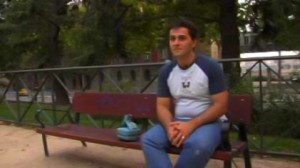
Pedro’s new home: Madrid.
PEDRO: Truthfully, air hockey has given me many good moments, some of the best moments in my life. It has helped me feel that I can attain what I set out to do. In some ways I feel empty having left air hockey. But if were up to me –- under ideal circumstances –- I would have continued playing for the rest of my life.
Air hockey is a sport that teaches you the skills to better yourself in life. And for me, it has helped me realize myself as a person. Others I have played with have made the same comment –- that it’s extremely fun and competitive, and you enrich yourself as a person while playing it.
But one of the best things about air hockey is that you become like a small family, and always maintain contact. We always know about each other. And wherever you go, other air hockey players will know you are there and seek you out. It is something like a chemical between us, between all of us who have played. And that is something special.
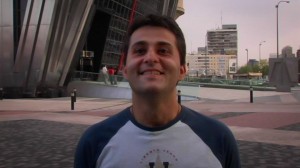
Vote for Pedro!
Thanks, Pedro!
Great Review in Suite 101
By Barbara DeGrande
Director Eric D. Anderson has documented a fast-paced, quirky sport; the unique individuals who are passionate about the sport; and its questionable future.
Eric D. Anderson, himself a one-time nationally rated air hockey player, puts his experience behind the camera to use in documenting the intense, little-lauded sport of air hockey in this, his first feature film. Like the sport itself, Anderson’s film is intense and offbeat, using antique stills and videos interspersed with stills and videos of the players in their younger days, some history of the sport including its NASA origins, and scenes of video arcades filled with aging mid-lifers pursuing their youthful dreams of success in a sport of their passion.
As arcades themselves begin disappearing, losing out to the burgeoning of computer and video games, these anachronistic advocates of a dying sport look at what is possible for the future of air hockey. Anderson’s film is always respectful of the sincerity of the air hockey advocates and the sport itself, yet spares none of the troubling aspects of the sport and its future.
Those who are invested in air hockey and its tournaments are a unique group of people, many with nicknames like The Wolf, The Juggernaut, and Egyptian Magician. There appears to be a small group of dedicated international players that love something of the incredibly quick reaction time of the sport, estimated at 1/600th of a second. Many have to buck negativity from spouses; others have full support and encouragement. One man reflects of the totality of his life against the fleeting victories of the sport he loves, trying to convince himself he has the better of the deal with his family behind him. Is air hockey a child’s game or a world-class sport?
Who is to decide? There are men in the inner circle of air hockey advocates that have spent their life promoting the sport, including guru Mark Robbins, who holds much of the history of the sport. When one young enthusiast is tossed aside by his girlfriend, he is told, “Air hockey still loves you.” For some, the diversion is a welcome relief from the difficulties of everyday life. There is no misery on the table: “Praise the table!” is the refrain. The profiles of the personalities involved in the sport is part of the delicious bits of this film that need to be savored.
One air hockey tournament offers a $14,000 prize, an all-time high for the sport. As men are seen taping their fingers for the next tournament, they reflect on their attitude towards the game. Two Venezuelans attend a tournament and are later discovered to have been using an upside down kitchen table to learn to play the game. Suddenly, the minority that is the air hockey corps reels from learning they are actually the privileged group in comparison with these enthusiasts.
The film flies us from their NASA origins to gaming in Japan to an air hockey expo on The Tennis Channel. One enthusiast discusses the need for a professional promoter to save the game; another is seen traveling from one tournament to another, investing everything in keeping the dream alive — even leasing the molds from a former distributor that has long since quit making pucks for the game. Perhaps Anderson’s film will do what others have failed to do and help regenerate interest and profitabililty in this short-lived sport. In any case, it is a fast-paced look at a piece of the culture of Americana grown global. Worth a look.
Nice Review in Just Press Play
By Tom Hoeler
If you grew up in America between 1970 and probably the turn of the century, chances are you’ve played air hockey at least once. A staple at arcades around the country, air hockey was also once a very popular addition for any family basement or entertainment room. That familiarity is the basis for Way of the Puck a documentary by director Eric D. Anderson that chronicles the growth, decline and near decimation of the sport, and the story behind those that play it competitively. Yes, there is competitive air hockey.
Watching the film certainly evokes memories of The King of Kong, another documentary that focused on the zeal and passion of a group of competitors devoted to another so-called fringe hobby, video games. While there are some similarities, The Way of the Puck seems far more tragic. For the players in The King of Kong video games are merely part of who they are. They have families, jobs and are relatively successful outside of the arcade. Additionally, the video game industry is booming, even if arcades themselves are dying out; so the pursuit of gaming records doesn’t seem as fleeting.
In contrast, for the players in The Way of the Puck this is their life…. (click link for rest of article)
Read more: http://www.justpressplay.net/reviews/7121-the-way-of-the-puck.html
Way of the Puck DVD Release Party
HOLLYWOOD, California: Way of the Puck, the just-released documentary about professional air hockey, was feted Thursday night at Barney’s Beanery’s landmark West Hollywood location. Air Hockey World Champion Davis Lee Huynh and second-ranked California player Joe Cain journeyed from the Bay Area to celebrate and to mentor guests about the finer points of air hockey tactics and technique.
Michael Rosen, Commissioner of Major League Air Hockey, traveled from New York City to meet the extended creative team behind Way of the Puck and to encourage more competitive air hockey play in the Los Angeles region. Rosen is one of four central characters followed around by director Eric D. Anderson in the feature-length documentary. “It was a perfect way to kick off our DVD release,” said Anderson. “We had guests fly in from all over the country, including a large contingent from Seattle. Then again, I shouldn’t be surprised, since fans of air hockey tend to be passionate people!”
Anderson and guests tried their luck against the three professional players on a new Dynamo Fire Storm air hockey table, purchased by Barney’s Beanery for the event. “It was important to me that we choose a venue where people could play a little… and hopefully re-experience the singular, inexplicable pleasure of hitting a lexan puck across a floaty blue surface.” Pucks and mallets were provided for the occasion by Mark Robbins, air hockey guru and CEO of Shelti, a Michigan-based table games manufacturer. Way of the Puck is the only feature film that digs into the curious subculture of competitive air hockey. It is currently available for sale at the film’s website: https://wayofthepuck.com
Way of the Puck DVD Design
Check out the new DVD casewrap for Way of the Puck! Many thanks to designer Eric Sommerfeld for his great work.
Please note that this collector’s edition DVD will contain:
- The full 81-minute Way of the Puck movie with Stereo 2.0 and 5.1 surround mixes
- Feature-length audio commentary with director Eric Anderson and air hockey guru Mark Robbins
- Eleven deleted scenes
- High resolution trailer
- Enhanced anamorphic presentation for widescreen televisions
- Our “Repeat after me: I can become the best air hockey player in the world, I just have to want it badly enough” postcard
- Scene selections
- Mr. Sommerfeld’s excellent DVD face and casewrap design.
Also note that the downloadable and streamable versions of WOTP available in the coming months will not contain these extras!
Philosopher Lou Marinoff Weighs In On the Importance of Air Hockey in Our Society
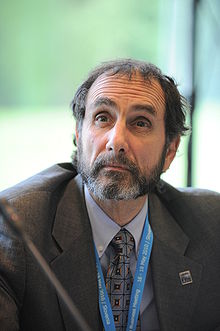
Lou Marinoff
Like many fringe sports, air hockey is an activity that inspires profound existential questions in those who love it. Nostalgic documentaries like Ken Burns’ latest effort seem like easy, non-threatening missions — we love baseball, it is our national pastime, and we also love our love of baseball, which usually harkens back to an earlier time in life, when we were more innocent, when players were drug-free (well, just a different kind of drug — speed, perhaps), when these athletes were real role models, heroes even.
What’s harder is placing air hockey (or darts, or shuffleboard, or baseball card collecting) in a similar context. There is no assumed national love for these activities. The same passion that is celebrated in Ken Burns’ beloved Baseball or Tenth Inning is called into question when looking at air hockey. But should we not celebrate passion for passions sake? How obviously worthy is hitting a ball with a stick and running around to different safe zones like a grown-up game of tag?
Three-time table hockey champion Lou Marinoff has given much thought to these very questions. As a philosopher and author, it’s difficult for him not to ruminate at length on society’s indifference to these outsider sports — why it is that the very that you’ve been chosen to do — that you excel at — is kicked to the curb, or even worse, ignored. And what to do about it.
We spoke at length to Mr. Marinoff about these and many other issues.
WOTP: What are the differences between air hockey and table hockey?
LOU: There are many differences between table hockey and air hockey, although they are related to the same pure form, as Plato would have it: the form of hockey. The whole idea is that you have a game with boundaries and you try to put a puck into a net. How many players you have, what kind of puck you have exactly, whether you hit the puck with a stick or with some kind of a knob depends naturally on the kind of game you’re playing, but it’s all related to hockey.
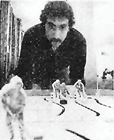
Lou on the prowl
The main thing is: With table hockey you have a team of players, which makes it look like ice hockey in miniature. You generally have a goalie and defensemen and wings, and you have the capacity to move, pass the puck back and forth. And generally one of these players will do the scoring.
In air hockey you have to do it all. You have one player who is basically controlling offense and defense together, very quickly. The transitions are very fast. And so the game is much faster. There are fewer possibilities in terms of who you are going to pass the puck to. There’s no one to pass the puck to, but you have to make a play off the boards or make a great defensive play, so there are similarities and differences, but it’s based on the same concept.
WOTP: Why does this appeal to you?
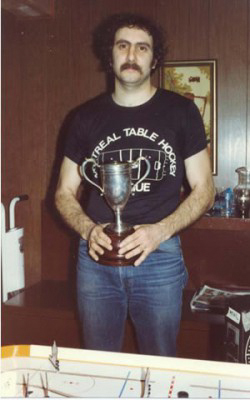
To the exhausted victor go the spoils!
LOU: There are a lot of reasons why this is interesting to me as a philosopher and as an educator, and the first one has nothing to do with hockey. It has to do with a bigger facet of the human being, and that is games and play. We are not the only animal that plays. The other primates play a bit—otters play, dogs and cats play occasionally—but human beings have taken and evolved the concept of games and play to a really high level and a lot of our lives are consumed with playing.
Playing is very important to children for their development and play is important for adults, one way or another, whether it’s games or sports. Most of us end up playing something on a lifelong basis. Music is play. That verb “play” applies to a lot of facets of human existence, so it’s obviously something important for our species. And then the question is, where do you grow up, what part of the world are you from geopolitically, so what are you going to be exposed to when you’re young, in terms of games? Hockey? This is a game more for the northern latitudes and kids grow up with great passion for it, whether it’s table hockey, ice hockey, field hockey, air hockey, it’s all part of the same great game.
WOTP: But is it always play? Or is it something else?
LOU: Philosophically this is interesting: What is a game doing? When we play a game, basically we engage simultaneously between competition and cooperation. We need to compete with each other because often competition brings out the best in a human being. You discover your excellence sometimes only when you’re under pressure, when you really have to come up with a great play, you know, come up with the goods! That’s what spectators come to games for, right? They want to see the athletes performing at a high level. So competition drives us achieve our best in terms of performance. But we also have to cooperate. Table hockey, air hockey, ice hockey—these games teach sportsmanship because you need the other person to compete. You go out there by yourself and you don’t have a game. You can go out there and skate around or just move the puck around, but you actually need another person to compete!
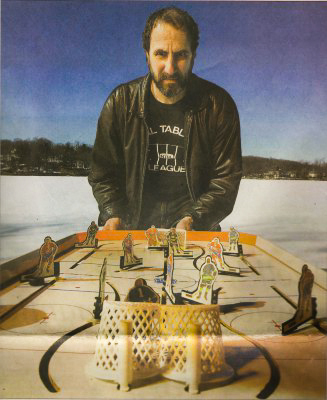
Toy? Game? Sport? Or something larger?
WOTP: I guess what I’m getting at is, well, is there some kind of line between game and sport and where do you draw that line?
LOU: Really it has a lot to do with the medium in which this game is being enjoyed and witnessed and are being transported. If you ask the manufacturers what they are selling, very often they don’t even think it’s a game… they think it’s a toy. Table hockey had this problem for a long time. The people who made it were toy manufacturers, and only understood toys.
Then when they say, “Hey wait a minute, grown men are taking this seriously, okay it must be a game. It’s got this competitive edge; there’s a lot of sophistication in it.” As in air hockey, I’m sure, there are very sophisticated plays that can be made and so forth.
So it looks like a game. But what happens to the top players when people get really good at this game? They find other people who are also really good and have achieved a great level of play, and then they want to compete seriously. At that point it’s sport. At that point it starts to taste like a sport. It’s not just a game anymore.
But it is a little different with air hockey and table hockey. Why don’t we look at pro football players, hockey, soccer, and say: “You’re playing a kid’s game, what’s wrong with you?” Of course they’re playing a kids game! The only way you could ever get to be a professional is to start early enough in life and get the muscular memory going—get the techniques into your immature neurological systems—so as you develop into a human being you have those skills!
WOTP: Do you ultimately think there is something rebellious about mastering an antiquated table game like this?
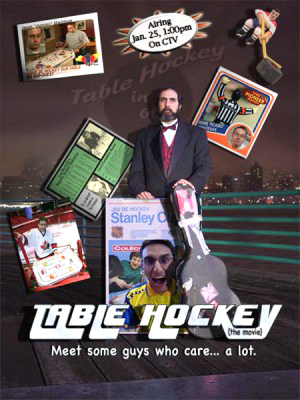
Lou’s other worthy film: Table Hockey (the movie)!
LOU: Well, the car was invented a while ago and it’s still with us. If you look at tennis racquets and baseball bats and footballs and soccer balls… there are a lot of things that were invented decades ago—maybe centuries ago—that are still with us! So I wouldn’t be too prepared to dismiss something just on the basis of its antiquity!
Sports evolve, however, and I think the point that you make that is really interesting, is to look at the contrast between computer games and virtual games and real games. I’m claiming that one of the strengths of air hockey and table hockey is that they are real and not virtual. I think people want more reality than what they are getting.
Ultimately, you can look at a game like Nintendo, which captured worldwide a generation of children. It was a universal language, actually, for children. They could all get together and play Nintendo. Whether it’s Sega or Gamecube or whatever, the fact of the matter is that these are virtual and not real. The action is taking place on a computer screen, not in a three-dimensional space-time setting and the skill set you need—however adroit these people are at manipulating the control pads—it’s not the same kind of hand/eye coordination you need in reality!
So table hockey and air hockey both belong to a class of games that are played in space-time, 3d, with a real opponent standing on the other end of the table. And there is something there that is irreplaceable.
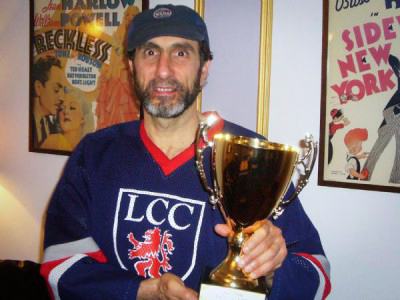
The Comeback Kid of table hockey!
We are human beings. As such we need to function in real terms as well as in virtual ones. And if you start asking people, “Which is better: e-mail or real mail?” Well, they’ll tell you e-mail’s faster, it’s cheaper, it’s instantaneous, we can communicate around the world and all that, but you know what, people should never forget about the satisfaction of writing a letter to somebody… and getting a letter from somebody. That’s something that you really keep and can cherish and reread and has a certain kind of value. I know that the visual tradition has unfortunately supplanted the written one, but people still need to appreciate the virtues of reality and if they can’t do it with literature and letters and stuff, because the e-thing is really what’s happening, they have to do it with sport!
And there is a certain satisfaction to scoring a goal in the real world that you will never be able to replicate in virtual terms!
—
Thanks, Lou!
Lou Marinoff is the author of many bestselling books, including The Middle Way, Therapy For the Sane, and Plato Not Prozac. His many areas of professional and personal interest are showcased at his website: http://www.loumarinoff.com/.
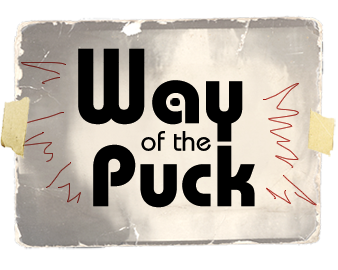
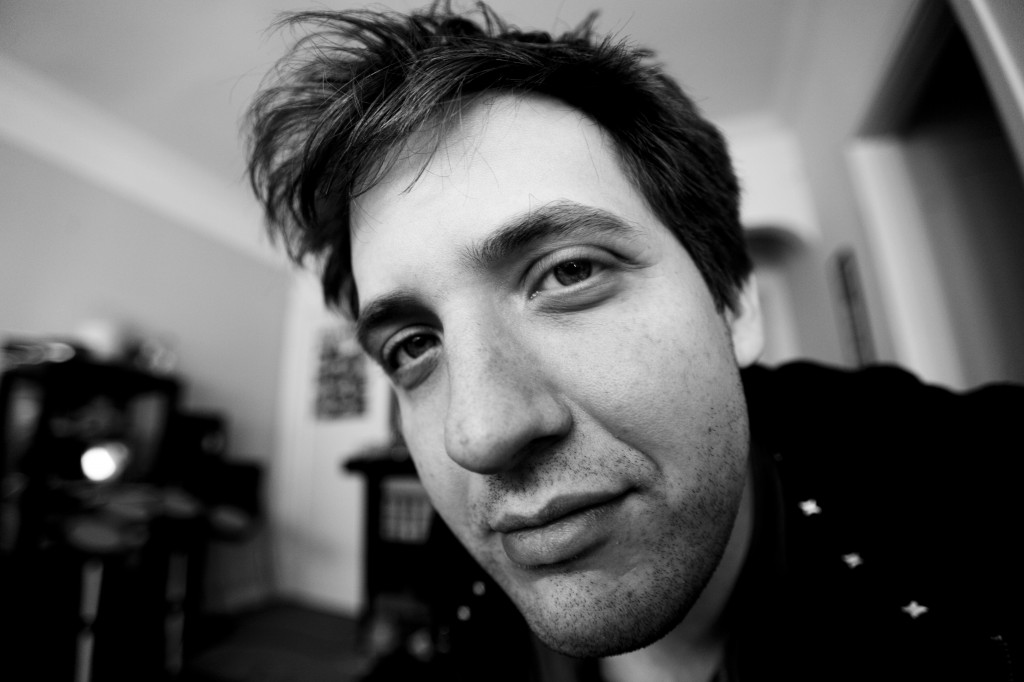


![[Stefan Fatsis], NASPA Person of the Year](https://i1.wp.com/wayofthepuck.com/wp-content/uploads/2014/08/Fatsis-Crop.jpg?resize=363%2C189&ssl=1)
















